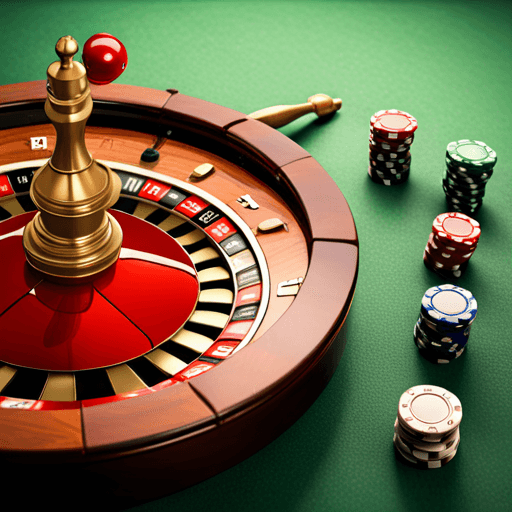French Roulette, a variant of the quintessential casino game, has been captivating players worldwide with its unique set of rules, lower house edge, and the allure of its French origin. With a more balanced wheel layout and a set of exclusive game rules, French Roulette stands out from its American and European counterparts. This guide will delve into the intriguing world of French Roulette, highlighting its rules, wheel layout, table structure, bet types, and strategies.
The Origins and Evolution of French Roulette
French Roulette, as the name suggests, finds its origins in France. The concept of roulette, which translates to "little wheel" in French, is believed to be the brainchild of the renowned French scientist, Blaise Pascal, who embarked on creating a perpetual motion machine in the 18th century. Despite his experiment's failure, it serendipitously led to the birth of the roulette game.
The game rapidly spread across Europe in the 19th century, despite gambling being outlawed in France at that time. The strategic alteration of the roulette wheel by the French brothers, Louis and Francois Blanc, brought about the modern-day single-zero wheel. Their innovation found its way to the iconic Casino de Monte Carlo, where it thrived among Europe's wealthy elites before making a global impact.
Unique Attributes of French Roulette
French Roulette shares many similarities with its American and European counterparts. However, there are key distinctions that set it apart and make it a preferred choice for many players. The most notable difference lies in the low house edge of French Roulette, attributed to its single-zero wheel and two unique rules — 'La Partage' and 'En Prison'.
Additionally, French Roulette boasts a distinct table layout, often featuring French terminologies. The game's aesthetic, combined with its player-friendly rules, makes it a fascinating variant for both novice and seasoned roulette players.
Understanding the French Roulette Wheel Layout
The French Roulette wheel layout is a critical aspect of the game. It consists of 37 compartments corresponding to numbers 1 to 36 and a single-zero pocket. The single-zero pocket is green, while the remaining numbers alternate between red and black.
The arrangement of numbers around the wheel is not sequential. Instead, it follows a specific pattern that ensures an even distribution of red, black, odd, even, high, and low numbers. This pattern is designed to maintain the game's randomness and prevent players from predicting the outcomes.
It's worth noting that each pair of even numbers on the wheel is followed by a pair of odd numbers, providing a balanced and symmetric layout.
Decoding the French Roulette Table Layout
The French Roulette table layout is similar to the European Roulette table layout, with a few noticeable differences. The table features 12 rows of three numbers in a grid, with the numbers increasing sequentially from 1 to 36.
The numbers on the table constitute the 'inside betting' zones. The 'outside betting' zones can be found below and to the right of the number grid. In many French Roulette tables, the outside bets are labeled in French. For instance, 'Pair' stands for even, 'Impair' for odd, 'Manque' for low, and 'Passe' for high.
Some tables also feature an oval-shaped 'racetrack' that displays the numbers in the same order they appear on the wheel, making it easier for players to place 'announced bets.'
The Fundamental Rules of French Roulette
The basic rules of French Roulette are similar to those of American and European Roulette. The game begins with players placing bets on a specific number or group of numbers. The dealer, also known as the croupier, then spins the wheel in one direction and releases the ball in the opposite direction. The aim is to predict the numbered slot in which the ball will land.
What sets French Roulette apart are the two unique rules — 'La Partage' and 'En Prison,' which come into play if the ball lands on zero.
-
La Partage Rule: If you place an even-money bet and the ball lands on zero, you lose only half of your stake. This rule effectively reduces the house edge on even-money bets to a mere 1.35%.
-
En Prison Rule: Similar to La Partage, this rule is applicable for even-money bets when the ball lands on zero. However, instead of losing half the stake, the entire bet is 'imprisoned' and carried over to the next spin. If the bet wins on the next spin, the original stake is returned to the player.
Types of Bets in French Roulette
French Roulette offers a vast array of betting options, categorized into 'Inside Bets' and 'Outside Bets.'
Inside Bets
-
Straight Bet: This is a bet on a single number, offering a payout of 35:1.
-
Split Bet: A bet on two adjacent numbers, with a payout of 17:1.
-
Street Bet: A wager on a row of three numbers, offering a payout of 11:1.
-
Corner Bet: A bet on a group of four numbers, with a payout of 8:1.
-
Line Bet: A wager on two adjacent rows of numbers, offering a payout of 5:1.
Outside Bets
-
Column Bet: A wager on one of the three columns of numbers, with a payout of 2:1.
-
Douzaine (Dozen) Bet: A bet on the first (Premier), second (Moyenne), or third (Derniere) set of 12 numbers, with a payout of 2:1.
-
Rouge/Noir (Red/Black) Bet: A wager on any red or black number, with a payout of 1:1.
-
Pair/Impair (Odd/Even) Bet: A bet on an odd or even number, with a payout of 1:1.
-
Manque/Passe (Low/High) Bet: A wager on low (1-18) or high (19-36) numbers, with a payout of 1:1.
Strategic Approach to French Roulette
When playing French Roulette, strategic planning can enhance the gameplay experience. Here are a few strategies to consider:
- Leverage the 'La Partage' and 'En Prison' rules.
- Place even-money bets for a higher probability of winning.
- Steer clear from betting on 'hot' numbers.
- Set a budget for betting and adhere to it.
- Establish loss and profit limits to manage your bankroll effectively.
Frequently Asked Questions about French Roulette
Q: How is European Roulette different from French Roulette?
A: While European and French Roulette both use a single-zero wheel, French Roulette incorporates the 'La Partage' and 'En Prison' rules, offering a lower house edge.
Q: Is French Roulette available online?
A: Yes, many online casinos offer French Roulette, allowing players to enjoy the game from the comfort of their homes.
Q: What are the unique features of French Roulette?
A: Unique features of French Roulette include the 'La Partage' and 'En Prison' rules, a single-zero wheel layout, and bets labeled in French.
In conclusion, French Roulette is a thrilling and strategic variant of the classic casino game. Its unique rules and balanced wheel layout offer players an engaging and potentially rewarding gaming experience. Whether you're new to the world of Roulette or a seasoned player, French Roulette is a must-try!
Author’s Biography

Thomas James is an experienced journalist and content writer who has worked in the online slots industry for years. He brings a wealth of insight and experience to his writing, having interviewed many of the leading slot developers and operators in the UK.

